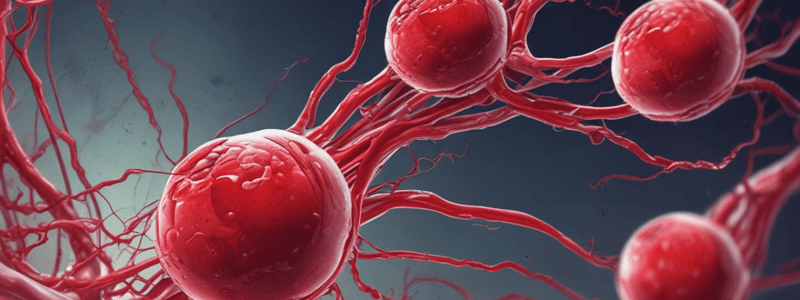Podcast
Questions and Answers
What is the primary function of antithrombin III in haemostasis?
What is the primary function of antithrombin III in haemostasis?
- To activate platelets
- To enhance fibrinolysis
- To inhibit thrombin formation (correct)
- To promote vasoconstriction
Which of the following is NOT a function of endothelial cells in haemostasis regulation?
Which of the following is NOT a function of endothelial cells in haemostasis regulation?
- Activating coagulation cascade (correct)
- Enhancing fibrinolysis
- Producing heparins
- Inhibiting platelet activation
What is the primary function of tissue plasminogen activator (tPA) in fibrinolysis?
What is the primary function of tissue plasminogen activator (tPA) in fibrinolysis?
- To convert fibrinogen to fibrin
- To inhibit thrombin formation
- To activate plasmin from plasminogen (correct)
- To activate factor VIII
Which of the following coagulation factors is NOT involved in the intrinsic pathway?
Which of the following coagulation factors is NOT involved in the intrinsic pathway?
What is the primary clinical feature of Von Willebrand disease?
What is the primary clinical feature of Von Willebrand disease?
Which of the following is a consequence of excessive thrombin formation?
Which of the following is a consequence of excessive thrombin formation?
What is the primary function of factor XIII in the coagulation cascade?
What is the primary function of factor XIII in the coagulation cascade?
Which of the following is NOT a component of the primary haemostasis?
Which of the following is NOT a component of the primary haemostasis?
What is the primary function of prostacyclin (PGI2) in haemostasis regulation?
What is the primary function of prostacyclin (PGI2) in haemostasis regulation?
Which of the following is a characteristic of bleeding disorders?
Which of the following is a characteristic of bleeding disorders?
Which of the following bleeding disorders is inherited in an autosomal recessive manner?
Which of the following bleeding disorders is inherited in an autosomal recessive manner?
Which step of haemostasis is primarily affected in Haemophilia A and B?
Which step of haemostasis is primarily affected in Haemophilia A and B?
What is the normal platelet count in a healthy individual?
What is the normal platelet count in a healthy individual?
What is the characteristic feature of bleeding in thrombocytopenia?
What is the characteristic feature of bleeding in thrombocytopenia?
Which of the following is a cause of thrombocytopenia due to decreased platelet production?
Which of the following is a cause of thrombocytopenia due to decreased platelet production?
What is the characteristic bleeding pattern seen in thrombocytopenia?
What is the characteristic bleeding pattern seen in thrombocytopenia?
Which of the following is a cause of thrombocytopenia due to dilutional thrombocytopenia?
Which of the following is a cause of thrombocytopenia due to dilutional thrombocytopenia?
What is the minimum platelet count required for spontaneous bleeding to occur?
What is the minimum platelet count required for spontaneous bleeding to occur?
What is the primary site of production of clotting factors in the body?
What is the primary site of production of clotting factors in the body?
Which of the following is a cause of disseminated intravascular coagulopathy (DIC)?
Which of the following is a cause of disseminated intravascular coagulopathy (DIC)?
What is the purpose of warfarin in the context of bleeding disorders?
What is the purpose of warfarin in the context of bleeding disorders?
Which laboratory test is used to measure the extrinsic pathway of coagulation?
Which laboratory test is used to measure the extrinsic pathway of coagulation?
What is the name of the condition characterized by an abnormal factor V that is not deactivated, resulting in thrombosis?
What is the name of the condition characterized by an abnormal factor V that is not deactivated, resulting in thrombosis?
Which laboratory test is used to detect thrombus formation, such as deep vein thrombosis (DVT) or pulmonary embolism (PE)?
Which laboratory test is used to detect thrombus formation, such as deep vein thrombosis (DVT) or pulmonary embolism (PE)?
Flashcards are hidden until you start studying
Study Notes
Haemostasis
- Haemostasis is the process of stopping blood loss after injury
- It consists of two parts: primary haemostasis (platelet plug formation) and secondary haemostasis (fibrin clot formation)
Primary Haemostasis
- Platelets are derived from megakaryocytes and have a discoid shape with no nucleus
- Platelets contain glycoproteins that interact with specific ligands
- Primary haemostasis involves the interaction of platelets, subendothelium, and fibrinogen
- Platelet granules are present in three types: alpha, dense, and lysosomal granules
Platelet Adhesion
- Endothelial injury exposes subendothelial matrix proteins to circulating blood
- Vasoconstriction occurs first, reducing blood loss, with nitric oxide helping in the process
- Von Willebrand factor (vWF) is released by endothelial cells and is important for platelet adhesion
- Initial platelet adhesion involves the interaction of vWF and the GP1b receptor on the platelet surface
Platelet Activation and Shape Change
- Binding of platelets to vWF triggers their activation, causing:
- Thromboxane generation (vasoconstrictor)
- Granule release (containing ADP, PAF, and fibrinogen)
- Activation of GPIIb/IIIa receptor (allowing platelets to bind to fibrinogen)
- Platelet shape change (swelling, forming extensions, and spreading across the subendothelium)
Platelet Aggregation
- Nearby platelets are recruited and become activated
- Following activation of GPIIb/IIIa, platelets begin cross-linking
- Nearby platelets bind to each other via the GP IIb/IIIa receptor, mediated by fibrinogen, and form a plug
Secondary Haemostasis
- Secondary haemostasis forms a stable mesh network and a permanent thrombus
- It involves a series of reactions involving coagulation factors (enzymes made by the liver) to produce thrombin
- Thrombin cleaves fibrinogen and forms fibrin
Coagulation Cascade
- The coagulation cascade has three pathways: extrinsic, intrinsic, and common
- The extrinsic pathway is activated by tissue factor (TF) released by endothelial cells after external damage
- The intrinsic pathway begins when factor XII becomes activated after exposure to subendothelial collagen
- The common pathway results in the formation of thrombin, which cleaves fibrinogen to form fibrin
Fibrin Clot and Fibrinolysis
- Fibrinolysis is the process of breaking down a fibrin clot
- The central protein involved in fibrinolysis is plasminogen, which is converted to its active form, plasmin
- Plasmin works by converting insoluble fibrin into soluble degradation products
- Fibrinolysis is an important process to prevent excessive clotting
Bleeding Disorders
- Bleeding disorders involve a deficiency in clotting factors or proteins important in the coagulation cascade
- Examples of bleeding disorders include:
- Von Willebrand disease (deficiency in vWF)
- Haemophilia (deficiency in factor 8, 9, or 11)
- Thrombocytopenia (low platelet count)
Thrombophilia
- Thrombophilia is a predisposition to thrombosis due to inherited or acquired defects of haemostasis
- Examples of thrombophilias include:
- Factor V Leiden
- Antithrombin deficiency
- Protein C or protein S deficiency
- Antiphospholipid syndrome
Laboratory Testing
- Laboratory tests used to diagnose bleeding disorders include:
- Prothrombin time (PT)
- Activated partial thromboplastin time (APTT)
- Platelet count
- Bleeding time
- D-dimer (detects thrombus formation)
Studying That Suits You
Use AI to generate personalized quizzes and flashcards to suit your learning preferences.



